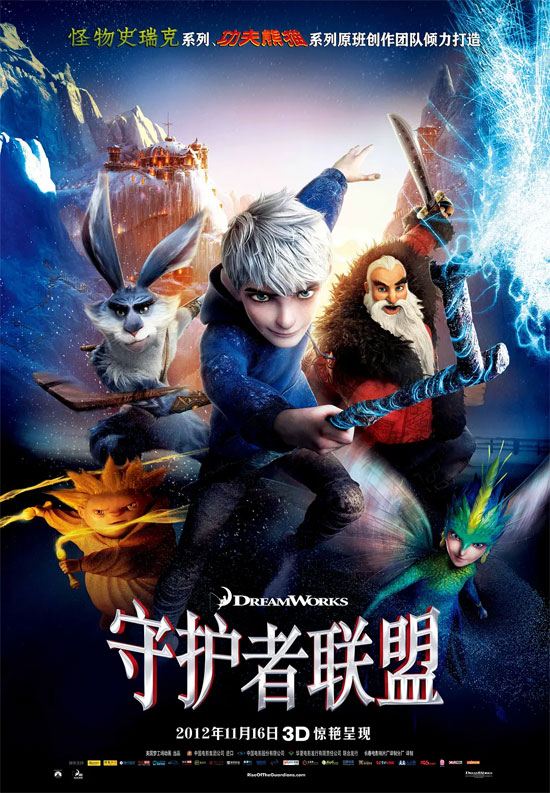Film Name: 守护者联盟 / Rise of the Guardians

No time for long reviews? Check out the short ones!
————————
The seemingly kind fairy tale characters defeat the seemingly evil nightmare, but this isn’t justice triumphing over evil—it’s just the idealist gang beating the realist gang.
The film’s color palette is way better than I expected, since the poster gave me the impression of a tasteless hodgepodge of colors.
The character names are poorly translated—Jack Frost sounds like a Japanese name, and the main villain being called “Bug Eater” doesn’t make sense since he doesn’t seem to eat bugs.
The main antagonist’s design is too ordinary.
Santa’s hair and beard are white, but his eyebrows are black—that looks weird!
————————
In the wilderness, there lies a tattered wooden bed, beneath which dwells an abyss inhabited by an evil nightmare. It brings terror to people, causing children to lose faith in beautiful fairy tales. Thus, the characters from these tales could no longer sit idly by; they resolved to defeat this nightmare and seal it back into the abyss. This was, in truth, merely a territorial dispute. It shares no fundamental difference from our own life-and-death class struggle, where we ultimately crush it beneath ten thousand feet to ensure its eternal defeat.
In my view, when seemingly virtuous fairy tale characters vanquish a seemingly wicked nightmare, it isn’t justice triumphing over evil—it’s merely one faction of idealism defeating another faction of realism. Ideals are not synonymous with justice, just as reality isn’t synonymous with evil. Perhaps for children, this brings fleeting idealistic joy, but in the long run, ideals must inevitably return to reality. Films like The Polar Express and Rise of the Guardians can never resolve the paradox of shattered ideals. The more they strive to fulfill a dream, the more they fear its inevitable collapse—a collapse we know is coming. Thus, when that day arrives, the sense of loss becomes all the more crushing. Who knows who will fall into the abyss then?
Therefore, what we must seal away is not fear itself, but the unchecked expansion of our dread that dreams might fall.
As a child, I watched a Japanese animation called “Thumbelina,” featuring a benevolent goddess and an evil goddess. The benevolent goddess constantly aided Thumbelina with her love, while the evil goddess devised every possible means to create difficulties for her. What struck me most was my expectation that Thumbelina would ultimately defeat the wicked goddess and rescue the trapped benevolent goddess. Yet the truth was different. In the final episode, the benevolent goddess and the wicked goddess stood together, jointly celebrating Thumbelina’s triumph after enduring countless trials. It turned out the Kind Goddess and the Evil Goddess were sisters, representing two essential aspects one must navigate to achieve success. Coincidentally, this trend has also emerged in modern Western children’s literature—not only showcasing truth, goodness, and beauty, but also incorporating fear and the harsh realities of life. Both are crucial for a child’s growth. Merely spinning idealistic lies is of no benefit to a child’s development.
Jack Frost possesses the power to control ice. If Santa Claus, the Easter Bunny, the Tooth Fairy, and the Sandman are functional characters, then Jack Frost is a functional character. The former fulfill their roles through their duties, while the latter fulfill their duties through their inherent functions. Thus, Jack Frost shares no fundamental difference from functional superheroes like Superman or Spider-Man in American comics. This similarity dictates that the film’s two most crucial plot elements mirror those in Superman films: first, how the superhero uses immense power to protect the vulnerable; second, how ordinary citizens sustain the superhero through their spirit. The former satisfies visual cravings—essentially primal desires—while the latter fulfills spiritual needs.
When the Nightmare King poses his iconic question—”You Guardians protect children, but who protects you?”—he is at his most powerful and arrogant. His query leaves the Guardians speechless. Yet when the child who still clings to fairy-tale dreams declares, “I will protect you,” the Guardians receive their ultimate spiritual support. Their subsequent defeat of the Nightmare King becomes a natural progression. In fact, the film contains another deeply moving scene: when only one child in the world still held onto fairy tale dreams, how Frozen Man fulfilled his duty to “guard,” using his own heart to reignite the lamp within that child’s soul. For the child, his dreams became reality; for Frozen Man, he found recognition. Guarding the child’s dreams ultimately meant guarding his own.
But the question remains: why was Frozen the only one capable of fulfilling this task? When the boy pleaded with his Easter bunny toy to perform magic, any other guardian could have protected his fairy tale dream if Jack Frost hadn’t appeared. Frost’s irreplaceability isn’t entirely clear—he was simply the first to arrive, and decorating Easter eggs with ice flowers was admittedly cool. Throughout the film, Jack Frost, the protagonist, is merely a character with a backstory, not one with a distinct personality. Like other superheroes, he possesses supernatural abilities and enjoys solving problems for others. Yet, as a perpetual loner, he initially resists joining the group until discovering his origins later in the story—that’s all there is to it.
Compared to other DreamWorks animations, nearly all the film’s humor relies on the antics of a few comic relief characters—whether it’s Shrek’s adorable quirks or Santa’s elves’ silly gimmicks. There’s almost none of the deep humor born from a character’s charm, like what we saw in “Shrek.” This is undeniably a disappointment. It may also explain why some foreign critics have labeled the film as “only suitable for children.”
Please specify:Anime Phone Cases » Rise of the Guardians 2012 Animation Film Review: The Battle for Territory Between Sweet Dreams and Nightmares